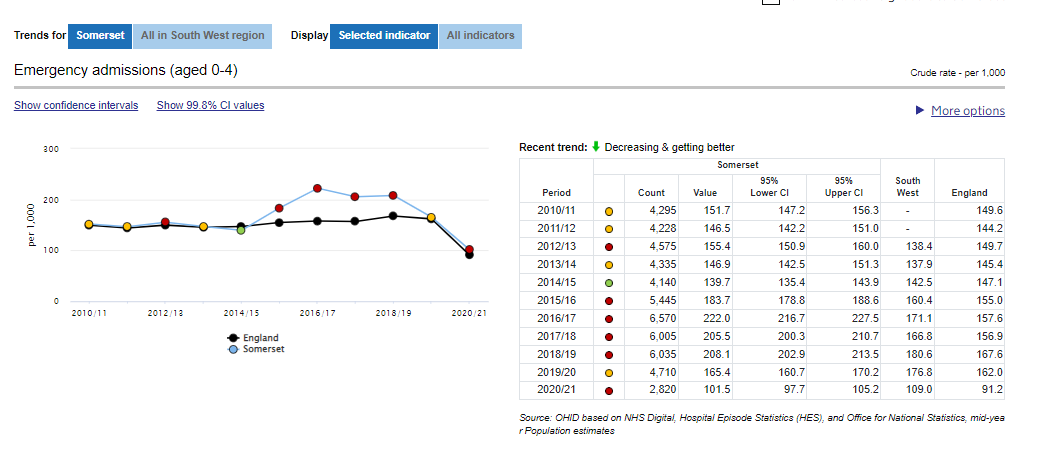Infant and Child Health
Not only are young lives intrinsically valuable, but starting out well lays vital foundations for a long and healthy life. An effective broad measure of the healthiness of a baby is the weight at birth. This measure strongly reflects inequalities in families’ health outcomes. Ensuring continuity of care for women from Black, Asian and minority ethnic groups is part of the Core20PLUS5 programme addressing inequalities.
The experience of vulnerable children and young people in Somerset was covered in the 2016 annual JSNA report. Detailed statistics are available in the Child and Maternal Health database (CHIMAT).
Low birth weight
Low birth weight increases the risk of childhood mortality and of developmental problems for the child and is associated with poorer health in later life. At a population level there are inequalities in low birth weight and a high proportion of low birth weight births could indicate lifestyle issues of the mothers and/or issues with the maternity services. Somerset figures are generally statistically similar to England as a whole.
Key indicator: Lower birth weight of term babies
More data at OHID Fingertips – low birth weight
Emergency Admissions age 0 to 4 years
Emergency admissions data gives an indication of wider determinants of poor health, linked to areas such as housing and transport. Over one quarter of emergency hospital admissions in children aged under five years in 2014/15 was for respiratory infections. Factors such as smoking in the home and damp housing are known to increase the risk and severity of respiratory infections in young children. Somerset has often seen higher rates than the England average, although with signs of recent improvement.
Key Indicator: Emergency Admissions age 0 to 4 years
Data before 2020/21 cannot be compared directly.
More data at OHID Fingertips – emergency admissions.
Oral health
Tooth decay is a predominantly preventable disease. High levels of consumption of sugar-containing food and drink is also a contributory factor to other issues of public health concern in children – for example, childhood obesity. Inclusion of this indicator in the Oral Health profile will encourage local authorities to focus on and prioritise oral health and oral health improvement initiatives to reduce tooth decay. The prevalence and severity of disease at age five can be used as a proxy indicator for the impact of early years services and programmes to improve parenting, weaning and feeding of very young children.
Key indicator: Percentage of 5 year olds with experience of visually obvious dentinal decay
More data at OHID Fingertips – decayed teeth. See also the Oral Health Needs Assessment for South West England.
School readiness
This is a key measure of early years development across a wide range of developmental areas. Children from poorer backgrounds are more at risk of poorer development and the evidence shows that differences by social background emerge early in life. Children are defined as having reached a good level of development if they achieve at least the expected level in the early learning goals in the prime areas of learning (personal, social and emotional development; physical development; and communication and language) and the early learning goals in the specific areas of mathematics and literacy.
Key indicator: School Readiness Percentage of Children with Free School Meal Status Achieving a Good Level of Development at the End of Reception
Data from before 2021/22 show trends, but cannot be compared directly to 2021 figures

More data at OHID Fingertips – school readiness
Overweight and Obesity
Excess weight is a major risk factor for circulatory disease and cancer. It is usually associated with excess food, inadequate physical activity, or both. The National Child Measurement Programme records levels of overweight in children at school reception (age 4 to 5 years) and Year 6 (age 10 to 11 years).
Key indicator: Reception Prevalence of Overweight including obesity
Next: Developing well
